What are the Hazards of UV Light?
Exposure to ultraviolet light can result in harmful effects to your skin or eyes that occurs without any initial pain or other warning symptoms. The harm may not present itself until minutes or even hours after the exposure. Prolonged exposure to certain UV wavelengths can increase your risk for cataracts or skin cancer.
Skin Injuries
Excessive skin exposure to UV in a short amount of time can result in redness, pain, and blistering, just like a sunburn. Prolonged exposure to UV can increase your risk of skin cancer.
Eye Injuries
Excessive eye exposure to UV in a short amount of time can result in injuries to the eyes. Symptoms include pain and redness of the eye, sensitivity to light, and a gritty feeling in the eye. Various symptoms are sometimes referred to as ‘Welder’s Flash’, ‘Arc Eye’, or ‘Snowblindness’. Prolonged exposure to certain UV wavelengths can increase your risk of cataracts.
For more detailed information on skin and eye injuries, refer to the “Further Understanding - How does UV cause harm?” section of the Georgia Tech Ultraviolet Radiation Hazards PDF.
What Sources of UV are There at Georgia Tech?
At Georgia Tech, UV is used primarily by researchers in laboratories or by Facilities Management in air handlers. There are some welding and cutting processes that generate UV as well. Some of these sources can cause harm in minutes or even seconds of exposure. Specific sources and protective measures are discussed below, but should not be considered a comprehensive list of UV sources at Georgia Tech. If you have any questions about a given type of UV source in your lab/work area, please refer to the section “Georgia Tech Resources” later in this document.
How Do We Protect Ourselves?
Engineering Controls
The best control measures are engineering controls. The UV source should be designed so that no skin or eye exposure can occur when the UV lights are on. This is often accomplished by the use of shields or interlocks that turn the light off when a door or port is opened.
Administrative Controls
All UV sources should have a conspicuous warning label at the point of access to the source. This label should warn the person that UV light is present, and that eyes and skin must be protected.
Finally, all new employees, faculty or students should be informed of hazardous UV sources (and all hazards, actually) that may be encountered in their work area, and how they should protect themselves from those hazards.
PPE
If engineering controls are not present or do not completely prevent exposure of your eyes or skin to the UV source, then you must wear personal protective equipment. For the UV sources listed here (except for lasers), appropriate PPE would consist of clothing that covers all skin (lab coat, gloves, pants, closed-toe shoes) and a polycarbonate face shield that covers the entire face. Pay attention to ensure that any exposed skin on the neck and wrist are covered.
Specific UV sources and protective measures are discussed below.
Common Sources of UV at GT, and Proper Protective Measures
Germicidal Lamps in Air Handlers
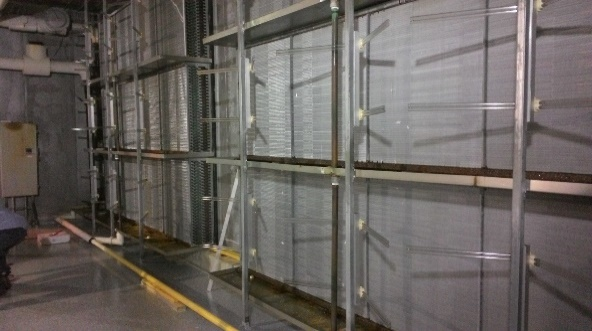 These are used for controlling microbial growth on cooling coils and is also helpful with disinfecting air as it is supplied to rooms and areas inside buildings.
These are used for controlling microbial growth on cooling coils and is also helpful with disinfecting air as it is supplied to rooms and areas inside buildings.
They are found in many buildings across campus but are typically in maintenance areas accessed only by Facilities Management.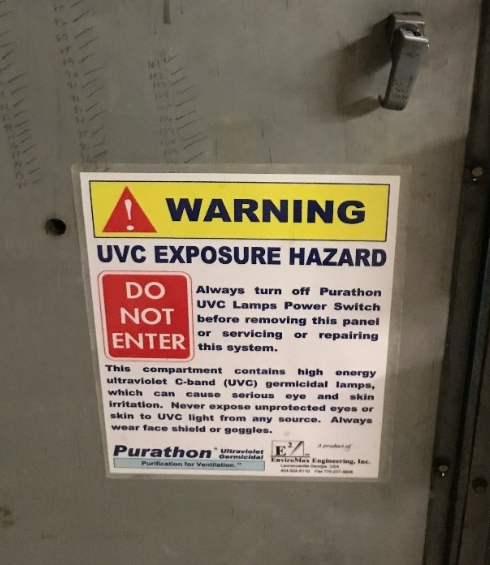
Exposure is controlled ideally by interlocks that prevent entry into the area with the lights on. Some of these air handlers do not have interlocks, but still have labels indicating the UV hazard inside. In either case, workers should be very careful to pay attention to the warning labels and make sure the UV lights are off before entering or working in the unit.
What PPE is needed? In the rare case that work must be performed with the UV lights on, GT EHS should be consulted prior to the work. Clothing that covers the entire body and a polycarbonate face shield must be used.
Germicidal Lamps in Biosafety Cabinets or Laminar Hoods
These are used for sterilization and disinfection, although their use for these purposes is no longer recommended. If you have questions about alternate methods of sterilization and disinfection, please reach out the Biosafety Office. (https://www.ehs.gatech.edu/biosafety)
They are found in laboratories, primarily for the biological sciences.
Exposure is controlled by closing the sash of the hood/cabinet whenever the UV lights are on. If the hood (e.g., laminar flow hood) does not have a sash, then PPE, as previously described, is needed when working where exposed to the UV light. Access to the UV light area should be controlled by the use of conspicuous warning labels and room postings, and by making sure all workers in the lab are aware of the hazard.
Transilluminators
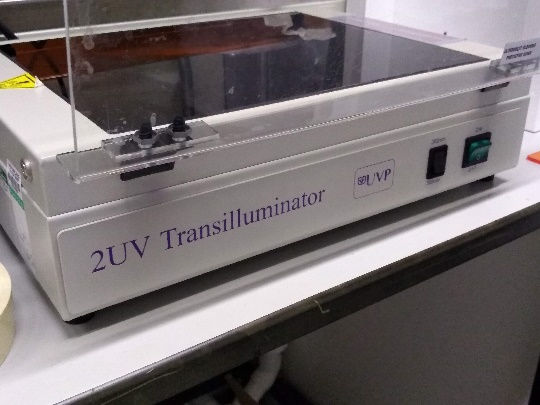
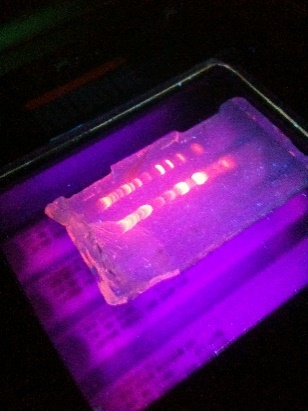 These are used for the visualization of DNA following gel electrophoresis and ethidium bromide staining.
These are used for the visualization of DNA following gel electrophoresis and ethidium bromide staining.
They are found in biological research laboratories.
Exposure is usually controlled by a UV shield that is placed over the gel when the unit is turned on. Often, these
shields have interlocks that prevent the UV lights from illuminating until the shielding is in place. If this shield does not completely cover the light, then PPE (as previously described) must be worn when working near the transilluminator. These units should not be placed in a highly trafficked area of the lab.
Users of transilluminators must not bypass the shield interlocks. Also, the unit should not be used if the shield is cracked or damaged. Keep this shield clean.
Handheld UV lights
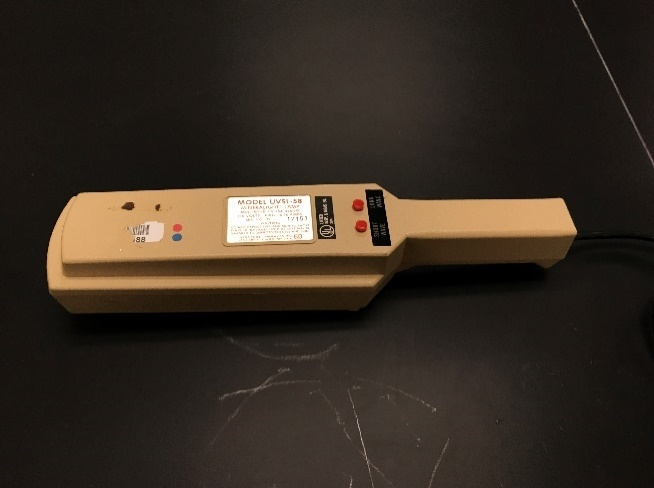 These are used primarily for visualizing nucleic acids following staining.
These are used primarily for visualizing nucleic acids following staining.
They are found in biological research laboratories.
Exposure is controlled by wearing PPE as previously described and never directing the UV light towards your face.
UV Mask Aligners
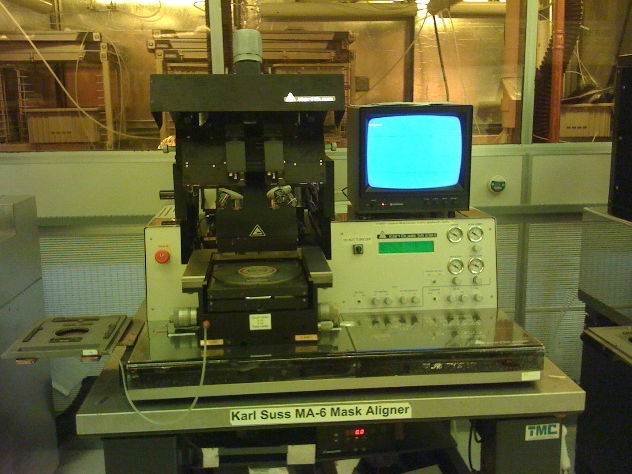 These are used to transcribe a fine pattern on a substrate using UV light. Substrates are made of various materials like silicon, glass, ceramic, GaAs, quartz, etc. They are used in the manufacturing of semiconductor devices, such as general transistors and Integrated circuits, and also used for LCD glass patterns and quartz crystal units.
These are used to transcribe a fine pattern on a substrate using UV light. Substrates are made of various materials like silicon, glass, ceramic, GaAs, quartz, etc. They are used in the manufacturing of semiconductor devices, such as general transistors and Integrated circuits, and also used for LCD glass patterns and quartz crystal units.
They are typically found in clean rooms.
Exposure is controlled by shields that are designed into the equipment by the manufacturer. Do not operate these devices without the proper shielding in place. If the device being used does not have built in shields, exposure is controlled by wearing PPE as previously described. When operated in cleanrooms, individuals are typically already wearing PPE that is protective.
Welding Equipment and Plasma Cutters
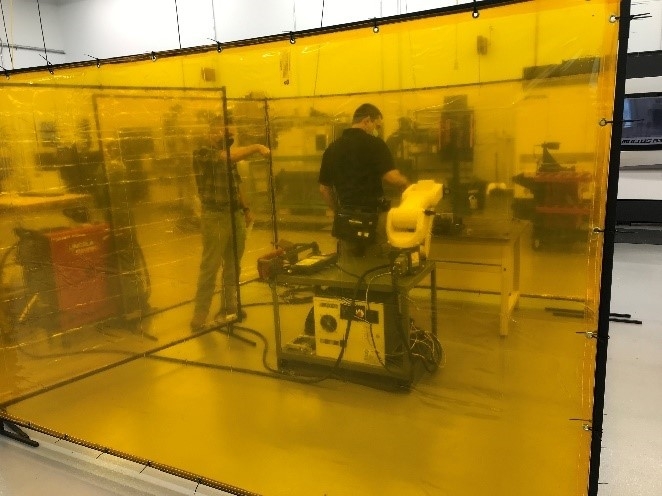
 These are used for welding and cutting metals in research-related machine shops and by Facilities employees in shops and repair locations on campus.
These are used for welding and cutting metals in research-related machine shops and by Facilities employees in shops and repair locations on campus.
Exposure to operators and individuals in the surrounding area is controlled with the use of UV blocking transparent curtains or welding curtains. For welding operations otherwise, the welder must wear full coverage clothing, gloves, and a proper welding helmet.
UV Lasers
These are used for various purposes in research laboratories. Users of UV lasers must follow the Georgia Tech Laser Safety Policy (https://www.ehs.gatech.edu/radiation/laser).
What Do I Do if I Think I Have Been Exposed?
If you experience skin effects similar to a sunburn, or eye discomfort following exposure to UV, then you should seek medical attention and follow the EHS Injury and Illness Reporting Guidelines, found under Occupational Injury Reporting at https://www.ehs.gatech.edu/general/occupational-injury.
If you believe you were exposed to UV, but are not experiencing any symptoms, you can contact the Office of Radiological Safety (ORS) at 404-894-3605 or ors@ors.gatech.edu. ORS can measure the UV intensity and determine if the exposure may lead to skin or eye injury.
Georgia Tech Resources
If you have a UV source that you are concerned about, contact ORS at 404-894-3605 or ors@ors.gatech.edu. ORS can measure the UV intensity and determine if the source has the potential to lead to skin or eye injury. ORS will also help make sure adequate controls are in place to prevent or reduce the likelihood of exposure.
Further Understanding
For further information on how UV can cause harm and recommended limits for exposure, see the Georgia Tech Ultraviolet Radiation Hazards document below.

